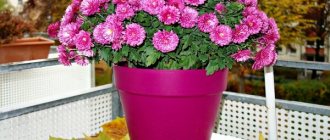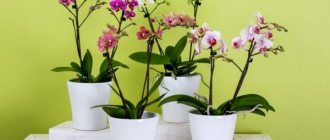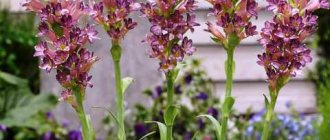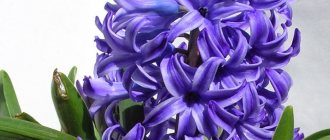Daffodils are among the earliest flowers to bloom in spring. Recognizable buds, consisting of 6 petals with a round crown in the center, decorate many garden areas, delighting everyone with a pleasant aroma and elegant beauty. They are quite unpretentious and in outdoor conditions do not require either annual digging or special maintenance. Growing these flowers in a pot will decorate any home or apartment, and will also allow you to get a fragrant bouquet not only in spring, but also at other times of the year.
Narcissus varieties for growing in a pot
The genus of daffodils belongs to the Amaryllis family and has more than 30 different species. Some of them adapt to indoor conditions better than others. The following are considered the most popular:
- Paper-like (Papyraceus) has up to 11 white flowers, each 3 cm in diameter. They are collected on a single peduncle that grows 30-45 cm in height. This is the only variety that does not require cold treatment and sprouts sprouts in the room within 2-6 weeks.
- Ziva (Ziva) with soft white small flowers, located up to 10 pieces on one stem. The height varies depending on the variety, reaching 15-35 cm in the miniature Paperwhite species, and 50 cm in Narcissus tazetta.
- Magnet has large single flowers, 12-14 cm each, with a yellow crown and petals that become lighter at the ends. It grows up to 40-50 cm in length, and is suitable for growing in containers with preliminary cold treatment.
- Avalanche is multi-flowered, that is, it has up to 10 buds arranged sequentially on one stem. Their rosette is golden and the petals are white. The height of the peduncle reaches 30-45 cm.
- February Gold (Ferbruary Gold) is distinguished by yellow flowers 7.5 cm in diameter, located one at a time on stems 30 cm high. Each of them has a double core and pointed petals.
- Snowball grows 43 cm in height. The white center and perianth make up a bud with a diameter of 8 cm. In the natural environment, flowers appear in May.
Flower growers also highlight varieties Geranium, Verger, Erlichir and others that are suitable for apartments. They can be colored in different combinations of white, yellow or beige, have a regular or fringed core, and a different number of perianth petals.
Botanical description with photo
Indoor narcissus (lat. Narcissus) belongs to the Amaryllis family. Each bulb has 2 renewal buds, each of which is at its own stage of development.
The shape of the modified underground stem resembles an elongated pear with a very dense brown skin.
Botanical characteristics:
- stem erect, flowering;
- leaf blades grow only at the root, forming a kind of green rosette;
- one peduncle, up to 40 cm in length, but there are multi-flowered varieties with 4–5 corollas;
- The color of the inflorescences is white, yellow, pink, orange, two-color.
Selection of bulbs
To get beautiful, healthy flowers, you should take care in choosing the material for planting. Very rarely, a seed is used for this, but the process of cultivating it is very long and labor-intensive. In most cases, bulbs are taken for these purposes, separating the children and mother bulbs. When purchasing them from third parties, you need to pay attention to the following criteria:
- Large material will give stronger seedlings;
- roots that are hard to the touch will ensure healthy plant development;
- soft and rotting areas may indicate the presence of disease or improper storage;
- spots and damage provoke the proliferation of bulb parasites.
Purchased bulbs should not be stored for a long time and it is better to plant them in containers as quickly as possible. If necessary, they can be placed in a dark, dry and ventilated place for some time. Otherwise, there is a risk of fungal infection or premature rooting.
Container for landing
Narcissus roots need space to reproduce and grow, so pots or containers need to be at least 15-20 cm wide and 30-35 cm high. For small varieties that grow no higher than 15 cm, you can take smaller containers, but still with sufficient depth for rooting. You should not overdo it in this matter, since excess space can harm the plant, delaying its flowering. The container can be ceramic or glass; wooden boxes are also suitable. Drainage in the bottom is required to remove excess moisture; it will prevent rotting in the bulbs.
Required soil
Soil for planting and replanting can be dug up in the garden or bought at the store. It should be soft, crumble in your hands and not stick together in lumps. It is better to dilute ordinary soil with sand or dry clay, add sawdust, wood ash and mineral fertilizers. This will make it loose, provide air circulation and enrich it with additional elements.
Some people use certain techniques to quickly obtain flowers, for example, so that they can give a bouquet for a holiday. To do this, they are planted in perlite or small stones and watered abundantly. The bulbs contain a sufficient amount of nutrients for the full development of the flower.
Conditions required for growing daffodils in a pot
This plant is one of the most unpretentious to keep. But to obtain beautiful and fragrant buds, he should be provided with an environment as close as possible to the natural one. To do this, you need to adjust the temperature, lighting of the room and humidity in it.
| Factor | Conditions |
| Location/lighting | The place should be chosen away from capricious plants that can be harmed by the toxins released by the narcissus. It should be sunny or slightly shaded, which will ensure abundant and long-lasting flowering. But it is better to avoid direct sunlight to prevent burns. |
| Temperature | After planting, cold treatment is required at +3...+9 °C, in the first days of embryo adaptation and during the flowering period about +10...+12 °C, and during the rest of the growing season no higher than +15...+18 °C. |
| Humidity | For full growth and development, at least 70%, especially after forcing the buds. Heating radiators dry out the air, so you should move the plant away from them, and you can place a container filled with water nearby. |
Classic Narcissist Problems
Failure to comply with the storage conditions of the bulbs, late extraction or insufficient processing can cause the appearance of fusarium rot. Distinct brown markings appear on the tubers.
At the initial stage, you can save the planting material using a fungicide solution. A badly damaged tuber must be disposed of.
Excessive use of organic matter causes sclerotial rot. Affected daffodils must be burned. A sharp cold snap and excessive humidity can cause gray rot in various parts of the plant.
Nematodes pose a particular danger to daffodils. There are two subspecies of pests that attack narcissus tubers and stems. The plant cannot be cured. The culture must be destroyed.
As a preventative measure, it is necessary to carry out heat treatment of planting material. Before planting, the soil must be disinfected with copper sulfate.
The narcissus fly damages stems and leaves. To combat larvae, the insecticide “Intavir-S” should be used. Peat can be used as a protective cover.
It is quite easy to take advantage of the natural “patrons” of narcissists. Planting the crop next to nasturtiums, marigolds or marigolds will repel pests.
Planting daffodil indoors
Planting bulbs indoors is a little different from outdoors. In particular, they will require cold treatment and forcing of sprouts in a specially created environment.
Landing dates
You can plant daffodils in the soil at any time of the year, but many people want to get flowering by a certain special date. Most often it is carried out in the following periods:
- planting no later than mid-autumn allows you to receive a bouquet for the New Year;
- bulbs rooted in December-January will bloom in the first days of spring;
- planting at the end of March will provide flower stalks for the May holidays.
More specifically, the timing is determined by the description of the variety, each of which has different periods of emergence.
The process of planting a daffodil in a pot
When planting bulbs in the soil, you should follow the step-by-step process:
- Place drainage consisting of 2-3 cm of crushed pebbles, pebbles or expanded clay into the selected container. It ensures the outflow of excess water and access of oxygen to the roots. Pour the substrate on top almost to the edges of the pot.
- Place the onions in it, pressing the roots down, leaving a distance between them. The upper part of each should be visible from the ground by at least a third. For a container 9 cm in diameter take 3 onions of 1 cm each.
- Water the soil with a small amount of water, which should not fall on the rhizomes. You can mulch the soil on top with a loose layer of leaves or sawdust. Before the shoots appear, it should be regularly added to prevent them from drying out.
- After planting, place the pots in a dark, dry place at a temperature of +3...+9 °C. If necessary, the container can be covered. Such difficulties are not required only by the Paper-like and Ziva varieties, which can be left right in the room.
- After germination of sprouts 5-7 cm high, no earlier than 1-3 months, they need adaptation to warm conditions. In this case, for the first 2-3 days, place them in a room with diffused light at +10 °C, and then you can choose a permanent brightly lit place at +15...+18 °C.
If everything is done correctly, the first flower stalks will appear in 1-1.5 months. A more accurate flowering time can be determined by knowing the variety of flowers being planted.
Narcissist influence
It has been scientifically proven that flowers with a pronounced pungent aroma can cause severe allergic reactions. The main signs of intolerance to the smell of daffodils:
- the appearance of itching;
- frequent sneezing;
- liquid discharge from the nasopharynx.
The plant contains a toxic substance called the alkaloid narcissin. Accidental consumption of any part of the flower may cause poisoning.
A poisonous plant can cause an allergic reaction and poisoning.
Caring for a potted daffodil
Care at home involves regular watering, fertilizing plants and pruning dry buds. They should be watered with settled water and only along the edges of the planting container or in the tray. The frequency needed is different at each stage of growth:
- For the first time, the soil needs to be moistened immediately after planting;
- during rooting, add water 2 times a month;
- after transferring the pots to a warm place, make sure that the soil does not dry out;
- during the flowering period, an increase in humidity in the air and soil is required;
- When the leaves turn completely yellow, stop watering.
From the beginning of sprouts to flowering, you need to feed daffodils with fertilizers containing phosphorus, potassium and nitrogen. It is worth carefully choosing the time and amount of fertilizing so as not to harm the flowers:
- At the beginning of the growing season, when seedlings appear, use a liquid or water-soluble composition.
- Then mulch the top layer of soil, spreading a thick layer of leaf humus or rotted manure on it.
- Introduce mineral fertilizing a second time when buds appear on the flower stalks and repeat the procedure once every 2 weeks until they begin to bloom.
- After flowering, mix bone meal or granular substances into the soil, which will allow seedlings to emerge in the second year.
In order for the flowering period to last longer, from the moment the buds open, you should ensure coolness in the temperature range of +10...+12 °C.
Which daffodils should you grow at home?
Daffodils can easily adapt to home living conditions, be in pots and delight the inhabitants of the house with wonderful flowers for a long period from winter to spring. But to do this you need to know what varieties of daffodils can grow at home. The following varieties are chosen more often than other varieties for indoor conditions:
- Papery;
- Little gem;
- Avalanche;
- February Gold;
- Ziva;
- Snowball.
Also, daffodils are grown at home: “Erlichir”, “Verge” or “Geranium”.
The most undemanding in terms of conditions of detention are “Avalanche”, “Paper-shaped”, “Ziva”. They are also characterized by the longest flowering period. Plant flowers can be of different colors: yellow, white, cream, beige. The Avalanche variety, for example, is characterized by the presence of white petals and a yellow core. "Erlichir" stands out for its unique velvety flower structure. Daffodils of different varieties can differ in size from each other.
Caring for daffodils after flowering
Once the daffodils have bloomed, the faded flowers are cut off and the green stem is left untouched. The abundance of watering is reduced, and slow-release fertilizers are added to the soil, which will be absorbed until the new growing season. Leaves and flower stalks can be cut off at the root only after they turn yellow and completely dry out. You should use clean scissors or a knife.
If the bulbs are not dug up, the container with them is moved to a cool place in the dark. The collected material is placed in bags made of fabric or paper. Next year it can only be planted in an open area, but for rooms it is worth selecting children.
It is also worth weeding out rotten and damaged onions by throwing them away immediately. And provide the rest with a dry and dark storage room. Flowers from one bulb can be grown up to 3 times, and for further propagation it is better to use their children.
Reproduction methods
Two methods are used for breeding daffodils: vegetative and seed.
Vegetative method
During the growing season, an average of two to four are formed from one bulb.
If you want or need to get new copies, you should adhere to the following steps:
- The dug up mother bulbs along with the daughter bulbs are cleaned of faded remains.
- Planting material is inspected for rejection and destruction of diseased or damaged bulbs.
- Healthy specimens are peeled, washed, disinfected for half an hour in a 1% solution of potassium permanganate, and then divided.
- First, the specimens are separated, falling off effortlessly, and those that are tightly pressed to the mother ones swing for independent separation.
- If the bulb comes off, the broken area is sprinkled with charcoal or activated carbon.
- Then the separated specimens are dried in a shaded place and placed for storage in a room with a constant temperature of no higher than 17 ºC.
Attention! You should not delay the time before planting: after a while, the bulbs lose moisture. The optimal storage interval from digging to planting is two months.
Seed method
Mr. Summer Resident warns: diseases and pests of indoor daffodils
When growing flowers, you can face many problems. Among them, the most common are the following:
- Fusarium fungus infection occurs with abundant watering, excess ammonia fertilizers, and keeping the bulbs warm and damp. To prevent disease, they need to be properly maintained and treated with fungicides before each planting. If a disease is present, plants and bulbs are discarded and destroyed.
- The large daffodil fly lays its eggs in the roots. Larvae emerge from them, feeding on the pulp of the onions and causing them to rot. To identify them, you need to press on the root; it should not be pressed at the top. The infected material should be treated with karbofos or kept in a pan of hot water for a couple of hours, maintaining the temperature no higher than +43 °C.
- Bulb aphids appear under dry scales and feed on the juices of rhizomes. This softens it, makes the plant sluggish, and impairs flowering. To eliminate the parasite, heat treatment in hot water is necessary, as is the case with a fly.
- Gray rot (botrythiosis) affects the leaves, leaving silvery and brown spots on them, then penetrates the rhizomes. Fungal spores develop when the air is over-humidified. To combat, 2 times a month, the infected areas are sprayed with 1-1.5% Bordeaux mixture, 0.5% captan solution or a copper-soap mixture (2 g of copper sulfate and 20 g of green soap). The roots are treated with 0.2% foundationazole.
- The onion mite lives in the soil and enters the bulb through damage. Plant growth stops, flowers and leaves wither. Damaged onions should be removed, healthy ones should be treated with heat.
- Nematodes feed on the juices of leaves and peduncles, from which they move into rhizomes. They combat it by heat treatment with water +40…+50 °C, into which the material is immersed for some time.
Infection often occurs due to insufficiently disinfected soil collected in the garden. In this case, sanitary treatment of the substrate will be required. In addition, to prevent narcissist diseases, you should adhere to the following rules:
- regularly loosen the soil and promptly remove dry and limp leaves;
- prevent soil waterlogging by creating drainage and balanced watering;
- create optimal conditions for planting material, store it at a temperature not exceeding +10 °C.
If you take all this into account, you can avoid many problems with growing daffodils. And then a blooming window sill will delight the eye for more than one day.
Narcissus on the plot
Daffodil flowers are one of the first to appear in the garden. Inflorescences bloom at the same time as crocuses, tulips and hyacinths. Growing an unpretentious crop in open ground is quite simple.
It is enough to choose the right zone for planting tubers. Daffodils develop well in well-lit, loose and fertile soils. A week before planting, you need to prepare the flower garden. The soil in the flowerbed should be thoroughly loosened. You can add medium-grained sand and humus (calculating 10 liters per 1 square meter).
Fresh manure can kill daffodils. Therefore, using the component during planting or for fertilizer is strictly prohibited.
Excessive alkalinity levels can be corrected by adding dolomite flour. High acidity is reduced with crushed charcoal.
When growing daffodils, it is necessary to take into account the rotation of crops. It is not advisable to plant a flower in an area after lilies, tulips and other bulbous plants. Perennial representatives of the flora - chrysanthemums, phlox and asters - also deplete the soil. You should choose a site with last year's cultivation of legumes or cereals. The soil after cucumbers or peonies is ideal.
It is not recommended to plant daffodils after bulbous plants.











